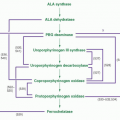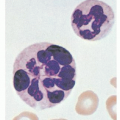The Diagnostic and Therapeutic Approach to Hematologic Problems
Maxwell M. Wintrobe
The study of the blood has a long history. Humankind probably always has been interested in the blood because it is likely that even primitive peoples realized that loss of blood, if sufficiently great, was associated with death. In biblical references, to shed blood meant to kill.1
THE FOUNDATIONS OF DIAGNOSIS
When and in what manner blood was first examined is unknown, but before the days of microscopy only the gross appearance of the blood could be studied. Blood allowed to clot in a glass vessel can be seen to form several distinct layers: at the bottom a dark red, almost black, jellylike material is seen; above this is a red layer; and still nearer the top of the clot is a pale green or whitish layer. Above these is the transparent, yellow serum. It has been suggested that perception of these layers in the blood after its removal from the body may have given rise to the doctrine of the four humors (black bile, sanguis, phlegm, and yellow bile), which were believed to constitute the substance of the human body. Health and disease were thought to be the result of the proper mixture or imbalance, respectively, of these four humors. This doctrine corresponding to the pervading concept of matter founded on the interrelationship of the four elements—earth, water, air, and fire—was set out clearly in the Hippocratic writings and was systematized into a complex metaphysical pattern by Galen in the 2nd century ad. It dominated medical thinking even into the 17th century.
Microscopic examination of the blood by Leeuwenhoek and others in the 17th century, and subsequent improvements in their rudimentary equipment, provided the means whereby theory and dogma would gradually be replaced by scientific understanding. The advance of knowledge was slow; however; those who were willing to observe and to seek greater understanding were few compared with the multitudes who repeated the age-old formulations. In the 18th century, William Hewson (1739 to 1774) made many important observations, and over the next 150 years or more, others gradually left their mark, including Gabriel Andral (1797 to 1876), Alexander Donné (1801 to 1878), Georges Hayem (1841 to 1933), and Paul Ehrlich (1854 to 1915), as well as Virchow, Aschoff, Maximow, Pappenheim, and still others in more recent times.2
However, it was not until the 1920s, beginning with the investigations of Whipple, Minot, and Castle, that the modern era of hematology started. From that time on, the field of hematology has flourished, and knowledge and understanding have grown at an ever-accelerating pace. The story has been told elsewhere.2 The reader will find revealing the comparison of the first edition of this textbook published in 1942, with subsequent editions.
At one time, hematology was a purely laboratory endeavor concerned with quantitation of the formed elements of the blood and the study of their morphology and that of the bone marrow, spleen, and lymphoid tissues. In the past 70 years, however, hematology has become a broad-based science that, in seeking to understand the normal and pathologic physiology of the hematopoietic system, uses all the methods of diverse scientific disciplines such as biochemistry, cell biology, immunology, physical chemistry, molecular biology, genetics, and nuclear medicine. As a consequence, the study of a hematologic problem can involve the use of procedures of great complexity.
Nevertheless, in the majority of patients whose illness may be regarded as being directly or indirectly related to the blood or blood-forming organs, examination requires only simple procedures. These begin with the steps fundamental and essential in the study of any clinical problem: a carefully taken history and a meticulous, discerning physical examination. It should be emphasized that the hematologist must be conversant with illness on a broad scale because, although certain diseases affect primarily the blood and blood-forming tissues, more often, disorders of other organ systems result in alterations in the hematopoietic system. A sound and thorough background is essential for the hematologist because modern oncologic therapy affects tissues other than those of the hematopoietic system and can be associated with diverse complications.
The symptoms of hematologic disorders are so varied and nonspecific that in themselves they may not suggest a hematologic problem. Thus, unexplained fever, extreme fatigability, or recurrent infections may or may not be caused by a hematologic condition. Likewise, physical examination may or may not direct attention to the hematopoietic system. The physical signs may be mainly those of congestive heart failure when the primary condition is pernicious anemia in relapse, adenopathy and splenomegaly when the underlying condition is a self-limited childhood infection, or nothing other than pallor when leukemia or aplastic anemia is the underlying disorder. In other instances, sternal tenderness, or bone tenderness elsewhere, hemorrhages, or spoon nails may direct attention to the hematopoietic system.
Stay updated, free articles. Join our Telegram channel

Full access? Get Clinical Tree








